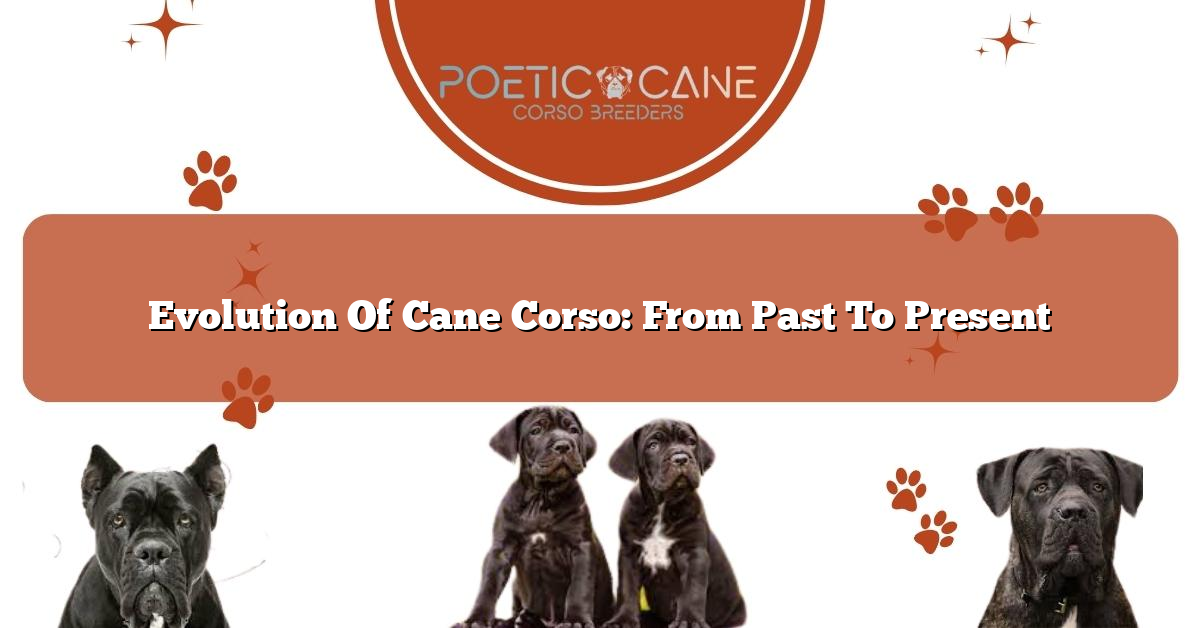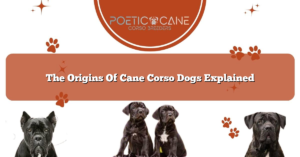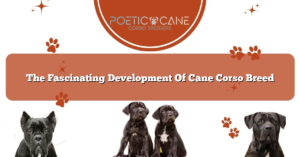Step into the captivating chronicle of the Cane Corso’s transformation, from its mesmerizing past to its present form.
Witness the evolutionary journey of this majestic breed, as it has evolved through the ages.
Discover the ancient roles it once served, the adaptations made during the Renaissance, and the breed’s standardization and recognition.
Delve into the distinctive characteristics that define the modern-day Cane Corso, shaped by selective breeding practices.
Explore the health concerns and genetic preservation efforts, and unlock the future prospects that lie ahead for this remarkable canine.
Key Takeaways
- The Cane Corso breed has a long history, dating back to ancient times in Italy, where they were originally bred and used as working dogs.
- Over time, the Cane Corso’s roles expanded to include guarding livestock and property, hunting wild boar, and even playing a role in Roman warfare.
- During the Renaissance period, the Cane Corso experienced a resurgence in popularity and became cherished companions to nobles and families, as well as being incorporated into military forces as war dogs.
- Today, the Cane Corso is known for its strong and imposing physical appearance, intelligent and alert expression, loyal and protective nature, and trainability, making it an excellent choice for experienced dog owners.
Historical Origins of Cane Corso
The historical origins of the Cane Corso can be traced back to ancient times, when they were bred and used as working dogs in Italy. The Cane Corso is a strong and powerful breed that was originally developed for various tasks such as guarding livestock and property, as well as hunting wild boar.
The breed’s evolution can be seen through its adaptability and versatility in different roles. Over the years, the Cane Corso has proven to be a loyal and protective companion, making it a popular choice for families and individuals seeking a devoted and reliable pet.
Despite its ancient lineage, the Cane Corso continues to thrive in the modern world, showcasing its enduring strength and resilience.
Ancient Roles and Functions
As we delve into the ancient roles and functions of the Cane Corso, let’s explore how their strength and versatility made them invaluable assets to their owners. The Cane Corso, a powerful and agile breed, was primarily used for various tasks throughout history.
They were exceptional guard dogs, protecting their owners’ properties and livestock from intruders. Additionally, their intelligence and loyalty made them excellent hunting companions, assisting in the pursuit and capture of large game.
Their versatility extended to being skilled working dogs, aiding in tasks such as pulling carts and guarding the homestead.
The table below highlights the different roles and functions that the Cane Corso performed in ancient times:
| Role | Function |
|---|---|
| Guard Dog | Protecting properties and livestock from intruders |
| Hunting Companion | Assisting in the pursuit and capture of large game |
| Working Dog | Pulling carts and guarding the homestead |
The Cane Corso’s multifaceted capabilities made them indispensable to their owners, establishing their reputation as a reliable and versatile breed throughout history.
Renaissance Resurgence and Adaptations
Continuing from their ancient roles and functions, Cane Corsos experienced a resurgence and underwent adaptations during the Renaissance period. As society shifted and new needs arose, the breed adapted to fulfill various roles. Here are some key adaptations that occurred during this time:
- Guardianship: Cane Corsos were increasingly utilized as guard dogs, protecting homes and estates from intruders.
- Hunting: Their physical prowess and agility made them valuable for tracking and hunting large game.
- Companionship: With their loyal and affectionate nature, Cane Corsos became cherished companions to nobles and families alike.
- Military Service: Their strength and fearlessness led to their incorporation into military forces, where they served as war dogs.
These adaptations not only ensured the survival of the breed but also solidified their place in society.
Today, Cane Corsos continue to exhibit these qualities, making them beloved pets and versatile working dogs.
Breed Standardization and Recognition
During the Renaissance period, Cane Corsos underwent further developments, leading to their breed standardization and recognition.
This process involved establishing a set of guidelines that defined the ideal characteristics and physical attributes of the breed. Breeders aimed to create a uniform and predictable breed type that could consistently perform its original functions.
The breed standardization process also involved the establishment of clubs and organizations dedicated to preserving and promoting the breed. These organizations, such as the Fédération Cynologique Internationale (FCI) and the American Kennel Club (AKC), played a crucial role in the recognition of the Cane Corso as a distinct breed.
Recognition by these reputable organizations not only solidified the breed’s status but also ensured that breeders followed specific criteria when breeding Cane Corsos, ultimately maintaining the breed’s integrity and preserving its unique qualities.
Modern-Day Cane Corso Characteristics
To understand the modern-day characteristics of the Cane Corso, you need to delve into its physical attributes and temperament. This powerful and athletic breed is known for its imposing presence and muscular build. With a square-shaped head, strong jaw, and alert expression, the Cane Corso exudes confidence and intelligence. Their short coat comes in various colors, including black, gray, and fawn.
In terms of temperament, the Cane Corso is known for being loyal, protective, and affectionate. They’re highly trainable and have a strong desire to please their owners. However, they also require firm and consistent leadership to ensure they remain obedient and well-behaved.
Here are some key characteristics of the modern-day Cane Corso:
- Strong and imposing physical appearance
- Intelligent and alert expression
- Loyal and protective nature
- Trainable and eager to please
These characteristics make the Cane Corso an excellent choice for experienced dog owners who can provide the necessary training and socialization.
Influence of Selective Breeding Practices
With selective breeding practices, breeders have played a crucial role in shaping the evolution of the Cane Corso breed. Through careful selection of desirable traits, breeders have been able to mold the Cane Corso into the powerful and versatile dog we see today. One of the main goals of selective breeding has been to maintain the breed’s original characteristics, such as its strength, agility, and intelligence.
Additionally, breeders have focused on addressing certain health issues that have emerged over time, such as hip dysplasia and eyelid abnormalities. By selectively breeding dogs with healthier genetics, breeders aim to reduce the frequency of these conditions in the breed.
The influence of selective breeding practices can’t be overstated, as they’ve allowed the Cane Corso to evolve and thrive as a breed while preserving its distinctive traits.
Health Concerns and Genetic Preservation
How can you ensure the health and genetic preservation of the Cane Corso breed? As a responsible owner, there are several steps you can take to promote the well-being and longevity of your Cane Corso:
- Regular vet check-ups: Schedule routine visits to the veterinarian for comprehensive health assessments and vaccinations.
- Balanced diet: Provide a nutritious and well-balanced diet to meet the specific nutritional needs of your Cane Corso.
- Exercise and mental stimulation: Engage in regular exercise and provide mental stimulation to keep your Cane Corso physically and mentally fit.
- Responsible breeding practices: If you choose to breed your Cane Corso, ensure that you select healthy and genetically sound dogs, and work with reputable breeders who prioritize the breed’s health and preservation.
Future Prospects for the Cane Corso
You should regularly evaluate the future prospects of your Cane Corso by considering their health, temperament, and conformation.
By monitoring their health, you can ensure that any potential issues are identified and addressed early on, promoting a longer and happier life for your dog.
Additionally, evaluating their temperament is crucial to determine if they’re suitable for various activities and environments. A well-balanced and stable temperament is essential for a Cane Corso to thrive as a family companion or a working dog.
Lastly, assessing their conformation, which includes their physical structure and breed standards, is important for maintaining the breed’s integrity and functionality.
Frequently Asked Questions
What Is the Current Population of Cane Corso Dogs Worldwide?
The current population of Cane Corso dogs worldwide is difficult to determine without specific data. However, as a dog enthusiast, you can stay informed by checking reputable sources and engaging with Cane Corso communities.
Are There Any Specific Training Techniques Recommended for Cane Corso Dogs?
There are various training techniques recommended for Cane Corso dogs. Consistency, positive reinforcement, and early socialization are key. Focus on obedience, leash training, and mental stimulation to help them become well-behaved companions.
How Long Does the Average Cane Corso Live?
On average, a Cane Corso lives for 10-12 years. However, some may live longer if given proper care and a healthy lifestyle. Remember, each dog is unique and their lifespan can vary.
Can Cane Corso Dogs Be Used for Search and Rescue Operations?
Yes, cane corso dogs can be used for search and rescue operations. Their intelligence, strength, and trainability make them well-suited for this role. They are capable of searching for and locating missing persons efficiently.
What Are Some Common Misconceptions About the Cane Corso Breed?
Some common misconceptions about the Cane Corso breed are that they are aggressive and not good with children. However, the truth is that they are actually protective, loyal, and can be great family dogs.

Sydney Kimberly is a passionate Cane Corso lover and dedicated breeder. With years of experience, she’s committed to raising these majestic dogs, ensuring they thrive in loving homes. Sydney’s expertise shines in her dedication to preserving the breed’s excellence, temperament, and health. Discover more about her Cane Corso journey and insights.




